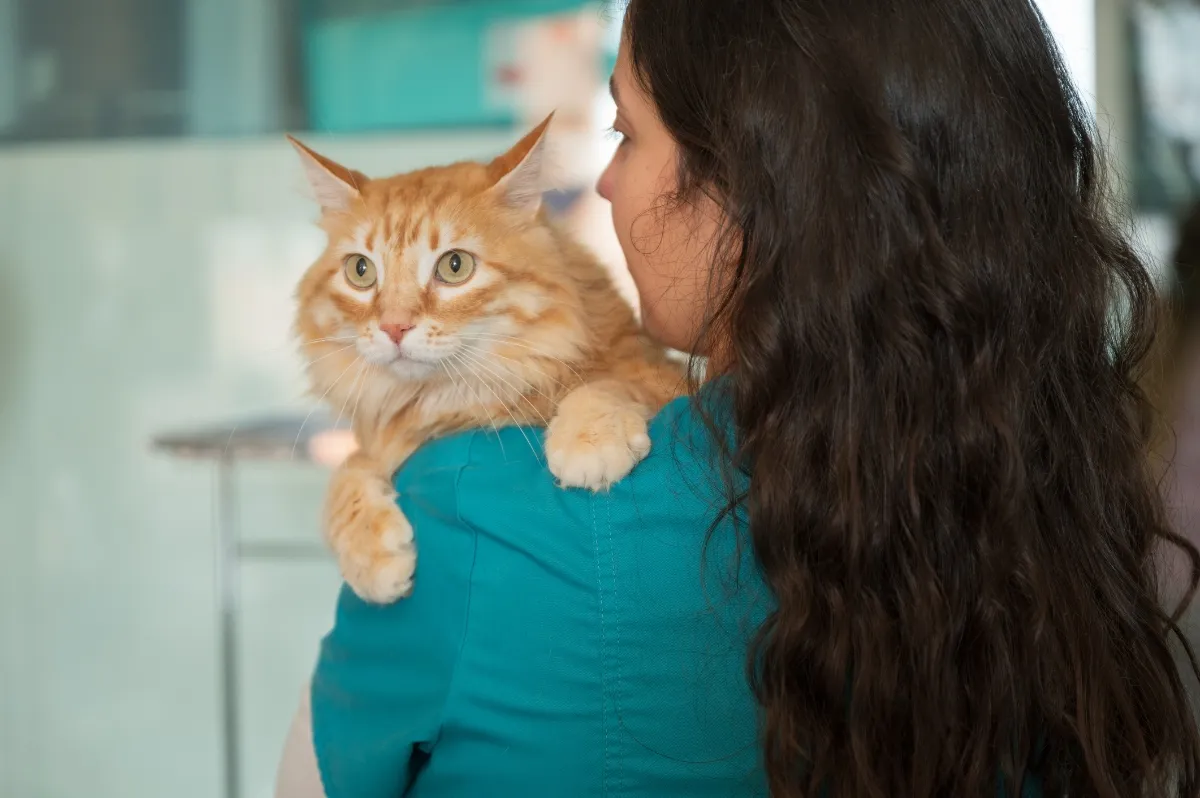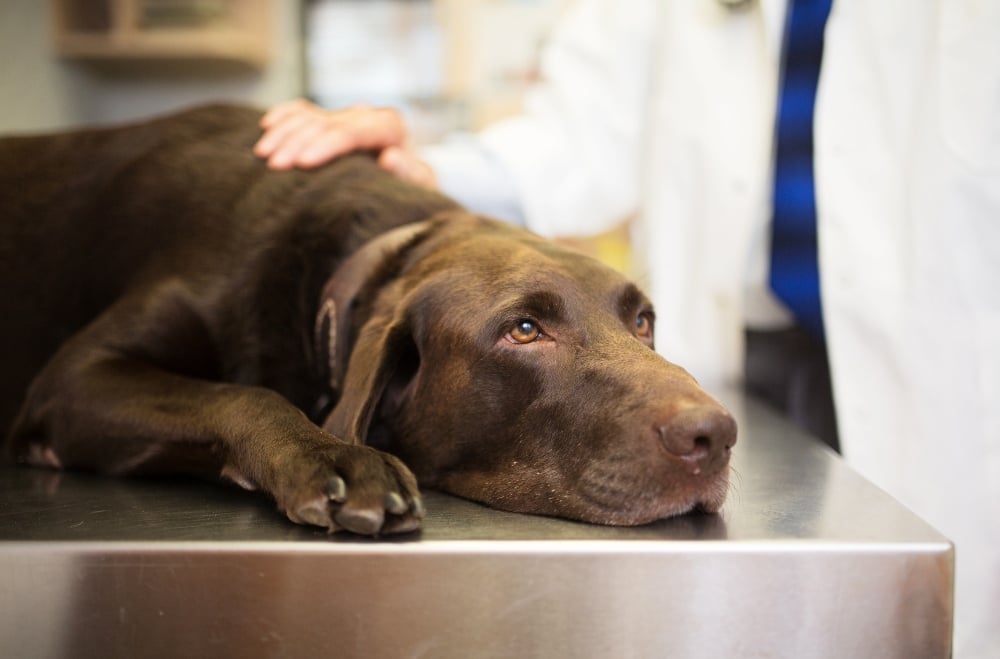Table of Contents
Emergencies strike without warning. That sudden Saturday night when your dog won’t stop vomiting, or the moment you realize your cat hasn’t urinated in 24 hours—these situations demand immediate action and often come with staggering bills. With 32% of Americans lacking even $400 in emergency savings, understanding what these visits actually cost can help you prepare for the unthinkable.
This guide walks through the ten most frequent pet emergencies, their typical treatments, and real-world costs without insurance. Consider this your financial roadmap for those critical moments when every second counts. While we hope you’ll never need this information, having pet insurance means you can say “yes” to necessary care without depleting your savings or delaying treatment.
If you suspect your pet is experiencing an emergency, contact your veterinarian or nearest emergency hospital immediately.
How Emergency Vet Bills Add Up
Emergency veterinary bills follow a predictable pattern. Exam fees typically start at $100–$300, often higher after hours or on weekends. Diagnostics form the next layer—bloodwork runs $150–$300, while X-rays add $150–$400, and advanced imaging like ultrasounds can reach $600. Treatment costs vary dramatically by severity. IV fluids cost $50–$200 daily, while emergency surgery ranges from $1,500–$5,000 depending on complexity. Hospitalization adds $200–$600 per day for standard care, or $500–$2,000 daily in the ICU. Finally, medications typically add $50–$300 for antibiotics, pain management, and other necessary drugs.
The 10 Most Common Pet Emergencies
1. Vomiting/Gastroenteritis ($500–$3,000+)
Gastrointestinal upset is the most common ER presentation and can range from simple dietary indiscretion to obstruction or toxin exposure.
Symptoms: Persistent vomiting, diarrhea, lethargy, loss of appetite, abdominal pain, dehydration.
Your vet will run blood tests and possibly X-rays to rule out obstructions or toxins. Treatment centers on IV fluids for dehydration, anti-nausea medications, and sometimes antibiotics.
Example bill: Emergency exam ($150), bloodwork ($275), X-rays ($200), 24-hour IV fluids ($200), medications ($100), overnight monitoring ($600). Total: $1,525.
2. Toxin Ingestion ($300–$5,000+)
Toxic exposures (chocolate, xylitol, grapes/raisins, medications) are a frequent driver of after-hours ER visits and can escalate quickly without prompt care.
Symptoms: Vary by toxin—chocolate causes tremors and seizures; xylitol triggers collapse within 30–60 minutes; grapes lead to kidney failure signs after 24–48 hours.
Treatment depends entirely on timing and toxin type. Early cases may need only induced vomiting and activated charcoal. Severe poisonings require days of intensive monitoring, IV fluids with dextrose for xylitol, or kidney support for grape toxicity.
Example bill: Emergency exam ($150), bloodwork ($275), induced vomiting ($150), activated charcoal ($100), 48-hour hospitalization with IV fluids ($900), monitoring ($500). Total: $2,075.
3. Trauma/Fractures ($1,000–$6,000+)
Falls, vehicle accidents, and rough play commonly cause traumatic injuries that require stabilization and imaging to determine severity.
Symptoms: Visible limping, swelling, wounds, inability to bear weight, pain when touched, abnormal leg position.
After stabilization, vets take X-rays to assess damage. Simple fractures might need only splinting, while complex breaks require surgical repair with pins or plates.
Example bill: Emergency exam ($150), X-rays ($225), surgical fracture repair ($3,500), 3-day hospitalization ($1,800), pain management ($300). Total: $5,975.
4. Urinary Blockage – Male Cats ($1,500–$3,500+)
Urethral obstruction is a high-risk emergency in male cats that can progress to dangerous electrolyte imbalances within hours.
Symptoms: Straining in litter box with little output, crying when urinating, frequent attempts, lethargy, vomiting.
This life-threatening emergency requires immediate catheterization. Without treatment, complete blockage is fatal within 24–72 hours.
Example bill: Emergency exam ($150), bloodwork ($275), catheterization under sedation ($400), 3-day hospitalization ($1,950), medications ($300). Total: $3,075.
5. Seizures/Neurologic Crisis ($1,500–$8,000+)
First-time seizures and multiple seizures within 24 hours are a common neurologic emergency, with treatment focused on stopping active seizures and finding a cause.
Symptoms: Sudden collapse with jerking movements, paddling, loss of consciousness, confusion, drooling.
Emergency treatment focuses on stopping active seizures with IV medications. Diagnostics include bloodwork and possibly MRI to identify underlying causes.
Example bill: Emergency exam ($150), bloodwork ($275), emergency anti-seizure medication ($150), 2-day monitoring ($900), additional medications ($200). Total without MRI: $1,675. With MRI: $4,675.
6. Bloat/GDV – Dogs ($2,500–$8,000+)
GDV (bloat) occurs most often in large, deep-chested dogs (such as Great Danes and Standard Poodles) and requires rapid diagnosis and surgery to prevent shock and organ damage.
Symptoms: Distended abdomen, unproductive retching, excessive drooling, restlessness, pale gums, rapid heart rate.
This condition demands emergency surgery to untwist the stomach and secure it to prevent recurrence. Pre-surgical stabilization with IV fluids and stomach decompression is critical.
Example bill: Emergency exam ($150), X-rays ($200), bloodwork ($275), emergency surgery ($5,000), 3-day ICU care ($2,100). Total: $7,725.
7. Heatstroke ($1,500–$7,000+)
Heatstroke surges during hot weather and in flat-faced breeds like Bulldogs, Pugs, and Persian cats; early cooling dramatically improves outcomes and reduces complications.
Symptoms: Excessive panting, bright red gums, temperature at or above 104°F, weakness, vomiting, collapse, seizures.
Treatment involves controlled cooling, aggressive IV fluids, oxygen support, and intensive monitoring for organ damage.
Example bill: Emergency exam ($150), diagnostics ($275), cooling therapy ($300), 2-day hospitalization with IV fluids ($400), monitoring ($1,300). Total: $2,425.
Begin cooling with room-temperature water while transporting—never use ice.
8. Pancreatitis ($1,500–$6,000+)
Pancreatitis affects both dogs and cats, ranging from mild GI upset to severe disease requiring intensive care.
Symptoms: Dogs show vomiting and abdominal pain; cats display lethargy and appetite loss. Both may have fever and dehydration.
Diagnosis requires specific blood tests and ultrasound. Treatment centers on IV fluids, pain management, anti-nausea medication, and nutritional support.
Example bill: Emergency exam ($150), pancreatitis blood test ($150), ultrasound ($450), 3-day hospitalization with fluids ($900), medications ($400). Total: $2,050.
9. Bite Wounds/Abscesses ($300–$2,000+)
Dog and cat bites may look minor at first but frequently develop deep infections that need drainage and antibiotics.
Symptoms: Visible puncture wounds, swelling, warmth, discharge, fever, pain, lethargy appearing 2–7 days after a bite.
Treatment involves draining the abscess under sedation, flushing the wound, and antibiotics.
Example bill: Emergency exam ($150), sedation ($200), abscess drainage ($400), wound treatment ($200), antibiotics ($75). Total: $1,025.
10. Parvovirus – Puppies ($1,000–$5,000+)
Parvo is a highly contagious viral disease in unvaccinated puppies that often necessitates multi-day hospitalization and isolation.
Symptoms: Severe bloody diarrhea, persistent vomiting, extreme lethargy, loss of appetite, dehydration, fever then hypothermia.
Parvovirus requires intensive hospitalization with IV fluids, antibiotics, anti-nausea medication, and 24/7 monitoring. Survival rates with treatment reach 85–95%.
Example bill: Emergency exam ($125), parvo test ($75), bloodwork ($275), 5-day intensive hospitalization ($1,500), medications ($750). Total: $2,725.
Why Emergency Costs Vary
Geographic location dramatically impacts pricing—urban and coastal cities charge 30–50% more than rural locations. Facility type matters: specialty emergency hospitals charge premiums for 24/7 availability. Pet size affects medication doses and surgical time, with larger dogs costing 20–40% more. Severity and complications exponentially increase costs. Timing also influences pricing, with weekend and overnight visits typically including 25–100% surcharges.
Planning Ahead for Emergencies
Building an emergency fund starts with setting aside $1,000–$2,000 specifically for unexpected pet medical costs. Even $25 monthly accumulates meaningful protection over time. Most plans work on reimbursement: you pay the vet bill upfront, submit a claim, and receive 70–90% back after your deductible, depending on the plan you select.
Pet insurance provides another financial safety net. Many plans reimburse a percentage of eligible costs after your deductible; pre-existing conditions are typically excluded. For example, with a $250 deductible and 80% coverage, a $3,000 emergency costs you $800 out of pocket—the $250 deductible plus 20% of the remaining $2,750.
Nearly half of pet parents have gone into debt paying for veterinary care, with average balances around $1,458—another reason to plan ahead before an emergency.
Consider your pet’s age, breed-specific risks, and your financial comfort when choosing deductible and reimbursement levels. Enrolling while your pet is young and healthy maximizes protection.
Additional options include care credit cards and payment plans. Many hospitals work with financing companies or offer arrangements for established clients.
Learn more about pet insurance or get a free quote from your preferred provider.
Key Takeaways
- Most ER visits land $500–$3,500; surgery/ICU can exceed $5,000–$10,000+
- Minutes matter for toxins, urinary blockages, heatstroke, and GDV
- Build an emergency fund of $1,000–$2,000
- Insurance typically reimburses 70–90% of eligible costs after the deductible
- Prevention saves: vaccines, spay/neuter, and pet-proofing avert common emergencies
Preparing Today Protects Tomorrow
Pet emergencies test us emotionally and financially. While we hope your pet never faces these situations, having pet insurance ensures you can say “yes” to essential care without financial hesitation—especially since nearly half of pet parents go into debt paying for emergency vet bills.
Remember that emergencies, while frightening, are treatable with prompt care. Having a financial plan removes one source of stress during those critical moments, letting you focus entirely on your pet’s recovery.
Your preparation today could mean everything tomorrow. Start with whatever you can—a small emergency fund, a quote for insurance, or simply knowing where your nearest emergency hospital is located. Every step counts when seconds matter.
If you suspect your pet is experiencing an emergency, contact your veterinarian or nearest emergency hospital immediately. When in doubt, it’s always better to seek professional evaluation.
† Cost ranges based on Healthy Paws Pet Insurance claims data (2022–2024), American Animal Hospital Association (AAHA) fee reference data, VCA Animal Hospitals emergency cost estimates, BluePearl Specialty and Emergency Pet Hospital pricing guides, and veterinary emergency practice surveys from the American Veterinary Medical Association (AVMA).







